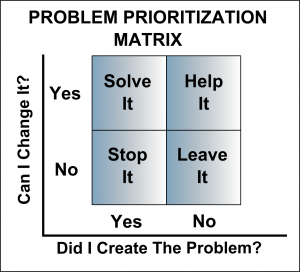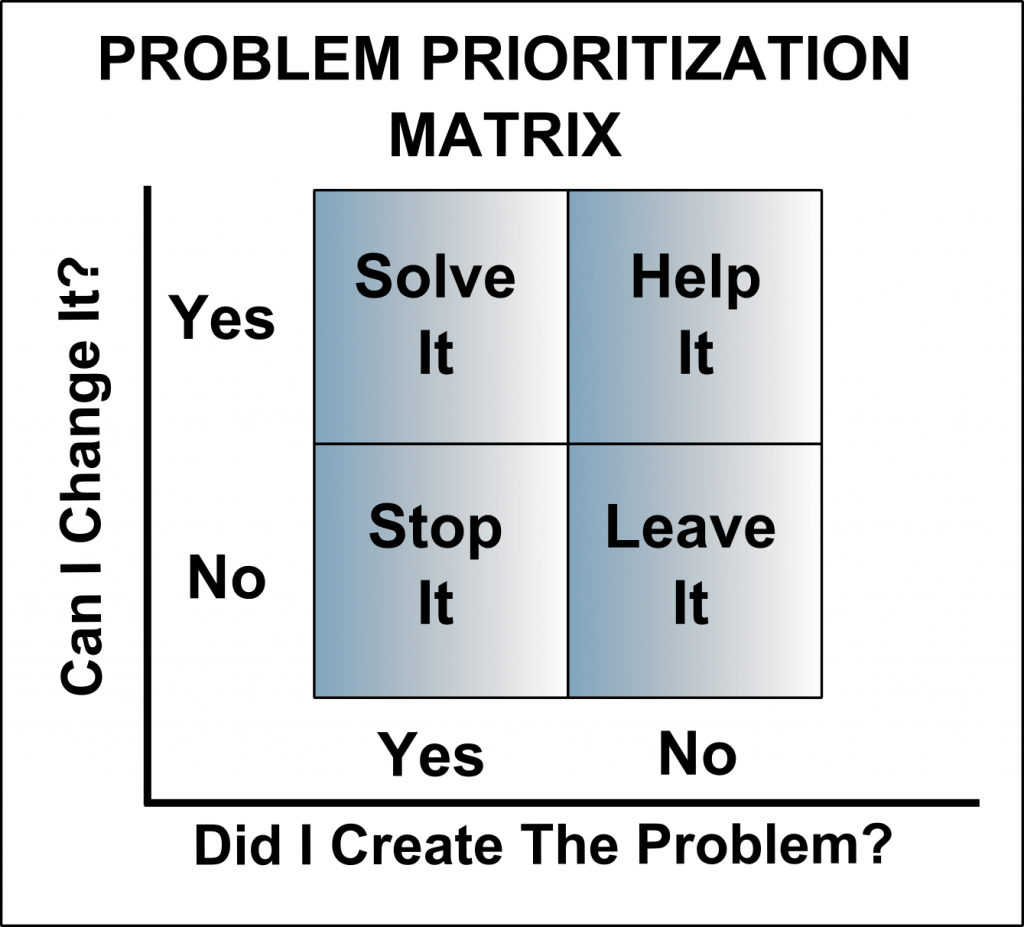Problem Prioritization
We all have a desire to solve problems. But we all have limits to our time and energy. We cannot fix everything. Therefore, we need to be selective about what actions we take and what problems we tackle. There are problems that we can solve ourselves, problems we cannot solve alone, and problems we cannot solve at all. If we devote our time trying to solve unsolvable problems it might make us feel good about ourselves in the short term, but we will feel unfulfilled in the long term. Above all, we should try to be effective. We need a process of problem prioritization.
Many people will try to get you to prioritize their problems above others. Sometimes they will draw upon talents of persuasion (or manipulation) to get you to take on their cause. Persuasion, usually in the form of highly emotional messaging, can cloud thinking and get you to commit to causes that will waste your energy while generating subpar results. We all need a way to clearly classify problems to help us choose the best ways to invest our valuable time and resources.

Problem Prioritization Matrix
I use the Problem Prioritization Matrix (PPM) to select the problems I wish to tackle. This simple tool helps me conserve my personal resources of energy and ensures that I am as effective at problem solving as I can be. The PPM asks two questions as criteria for problem prioritization: 1. Did I have a hand in creating the problem, and 2. Can I do anything to change the situation? The way those questions are answered creates a 2X2 classification matrix.
Solve It
The upper left hand quadrant comprises those problems which you have the ability to make change and which you have a hand in creating. Your goal here is to Solve it. This quadrant should be your primary focus, especially initially. I would argue you have a responsibility to work on these problems because you are, in part, their author. And with time, as you solve problems and refuse to create more, you can spend more time in the upper right hand quadrant.
Help It
The upper right hand quadrant includes those problems which you had no role in creating, but can nevertheless make a positive impact toward solving. This is the embodiment of charity and being helpful. In fact, the goal here is to Help It. The world is filled with problems with which you can uniquely make effective efforts at solving. By solving problems, you can enjoy no end of enrichment, satisfaction, and fulfillment. But since you had no role in creating the dysfunction, chances are, without enrolling the problem creators in your efforts solving problems will be ineffective because the behaviors that led to the problems remain uncorrected. Eerily similar problems will emerge. This tends to lock you into a pattern of repeated and inescapable problem solving This is how people become codependent with dysfunction and it will stymie you at-best and consume you at-worst. You must get commitment and cooperation from those who created the problems to have any hope of solving the problem. If you can’t, then you should move down to the lower right hand quadrant.
Leave It
The lower right hand quadrant of the PPM consists of those problems with which you have no role in their creation and with which you have no ability to solve. These Leave It problems are the ones best left alone. Putting your heart into unsolvable problems is a recipe for burnout, despair, and cynicism. The best thing you can do is to avoid these problems and put your attention into solving the problems in the upper two quadrants.
The time may come when change occurs which makes what once was impossible, possible. At that time the problem moves from the lower half of the PPM to the upper. When this occurs, you can reconsider tackling the problem.
This is not to say that you shouldn’t devote yourself to doggedly persistent problems. There is great virtue in striving for lofty goals, even seemingly unrealistic ones. Because building change momentum usually takes time—sometimes more than a single lifetime. But when tackling persistent problems, it is important to maintain a healthy perspective. Set your expectations appropriately and reinforce your internal support mechanisms to maintain your energy and motivation. As is said on every commercial flight, “Secure your own mask before helping others.”
Stop It
The lower left hand quadrant consists of those problems that you helped to create, but no longer have the power to solve. Sometimes our actions set processes in motion which take on a life of their own. Dysfunction is no different. When you find yourself in a bad situation, partly of your own making, without the ability to salvage the situation, it’s torturous. When it happens to me, I feel sick—overcome with guilt and regret. But I know that I’ve lost control. I’m limited in what I can do to fix things. All I can do is refuse to participate in dysfunction any longer. I can Stop it. Problems may continue, but I will no longer continue to be one of its authors. You may also hope that people seeing you withdraw will be inspired by your example. We often under-appreciate the power of our influence.
The Problem Prioritization Matrix is a powerful tool to assist you in choosing what problems to tackle and to provide some peace in mind that you are doing what you can to make a positive difference in the world.

